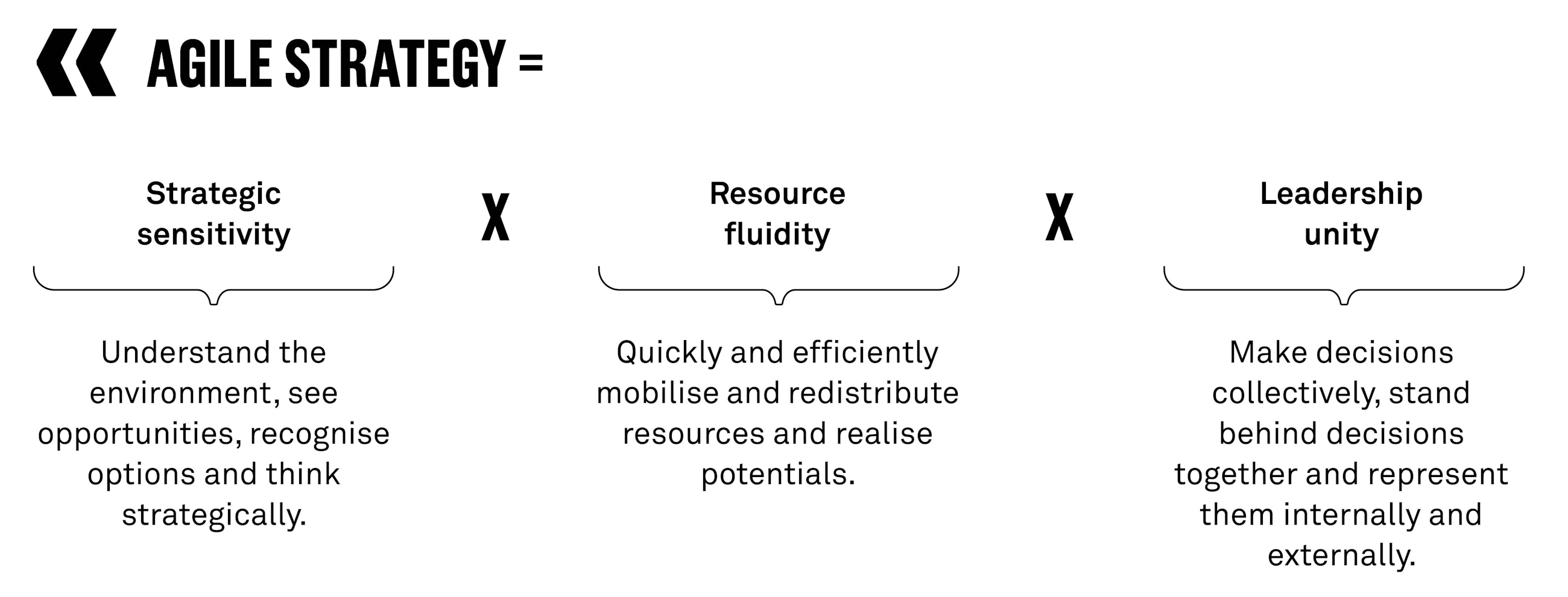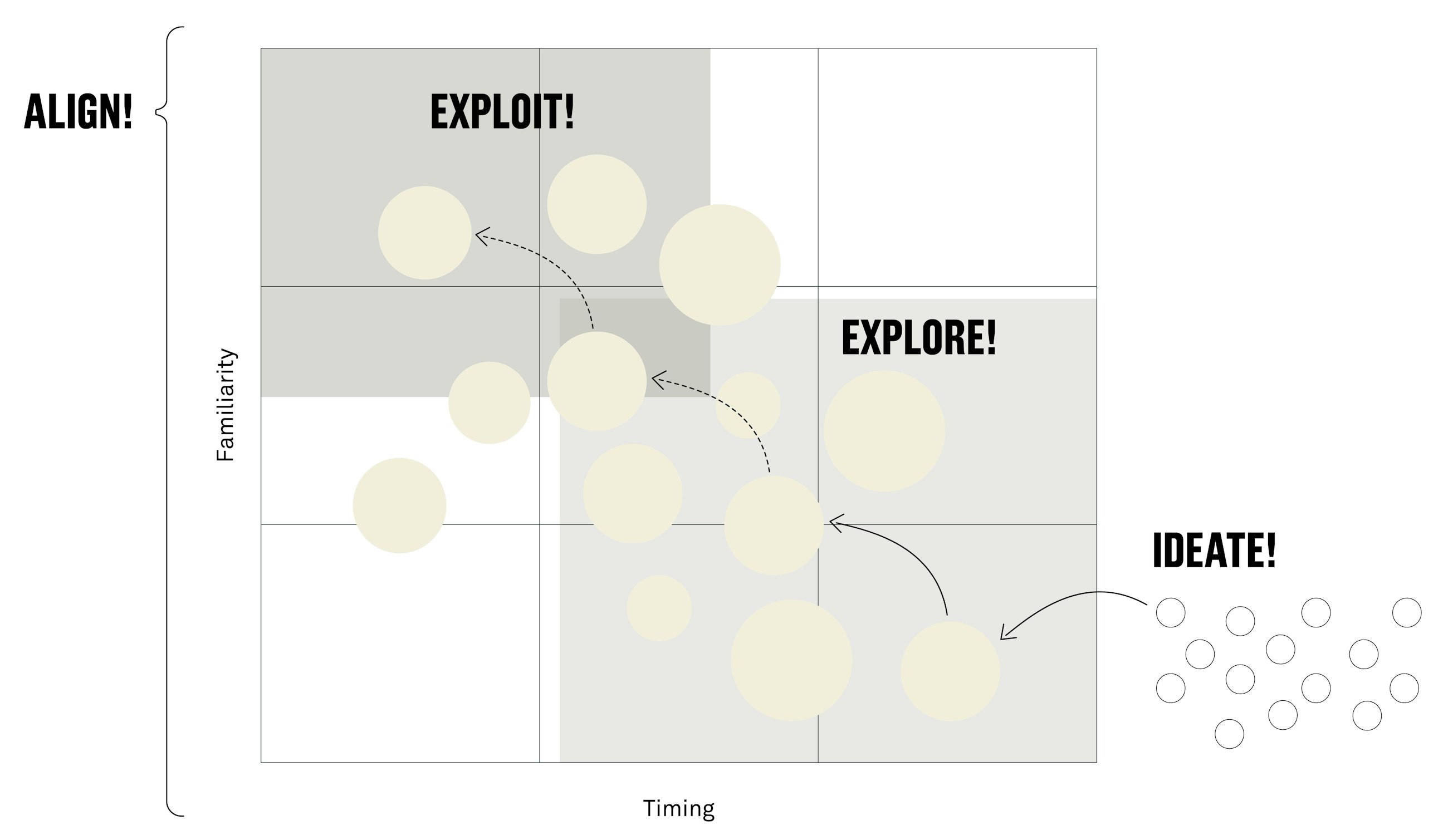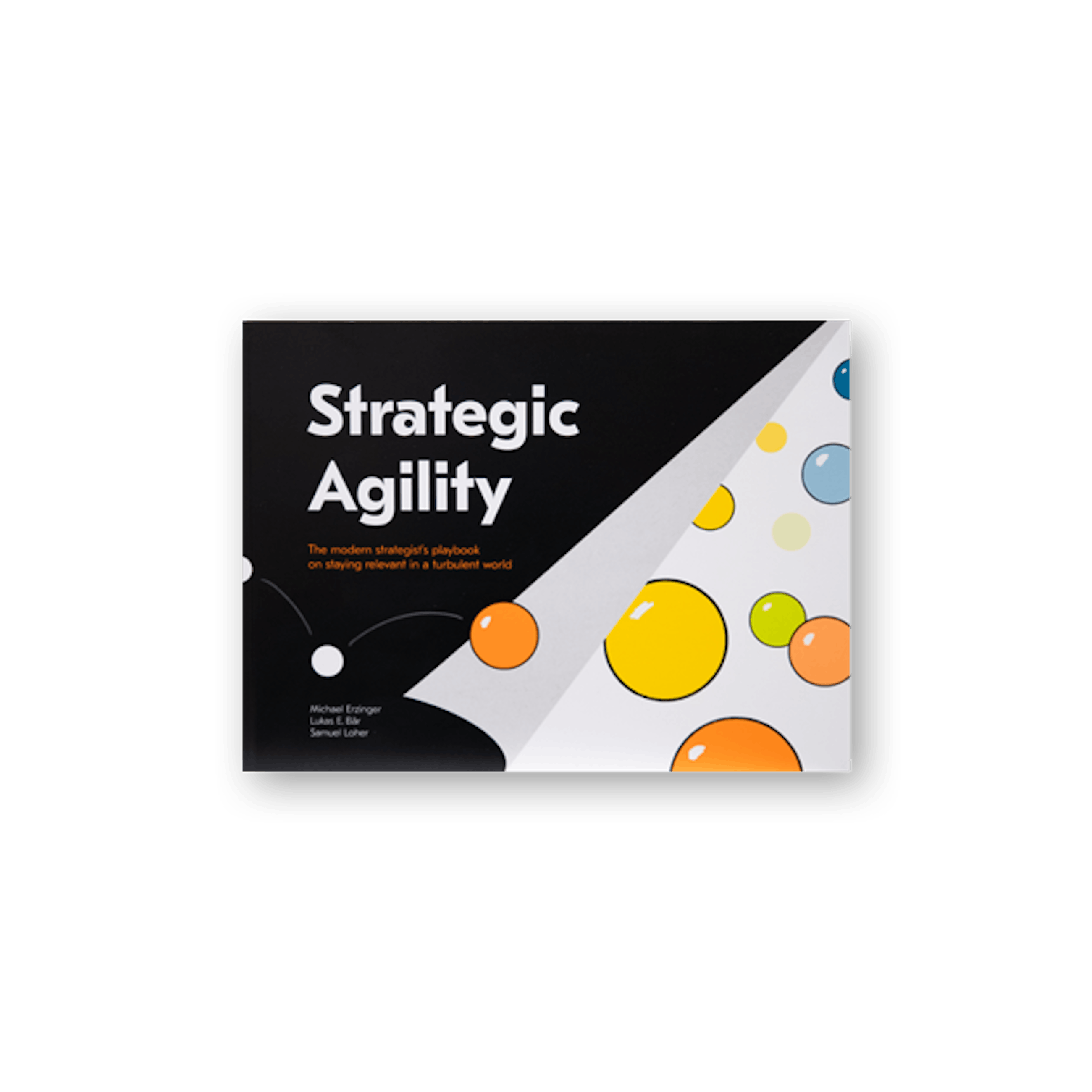Three key elements for an agile strategy
Read the first article, “Organisational Agility – building a backbone to handle constant change” here.
16 December 2020
An organisation derives much of its purpose and direction through its strategy. To develop organisational agility, we suggest that the first step is to align the strategy throughout your organisation with your transformation ambition.
Today, the pace of change is on the rise, and so the traditional understanding of strategy formulation and execution has become obsolete. Strategy, the way we see it, is not about rigid 3-5- year cycles, inflexible tools and tedious processes which slow down the decision-making process and time to market.
In unpredictive, complex and dynamic environments, strategy is all about fast learning, experimenting, monitoring and reacting quickly to constantly changing circumstances. And so, to be able to identify new, innovative opportunities early and to exploit them successfully, you need a more agile strategy approach.
Challenges of an agile strategist
As agile strategists, we have identified three major challenges that today’s organisations usually suffer from.
Firstly, most organisations have undertaken various experiments with agile methods and tools. Especially large companies have successfully implemented them under lab conditions, e.g. within product development and IT. But nearly all the companies have failed to transform the learnings from those first-hand experiences into management processes and more specifically into strategising.
Secondly, even companies with a high sense of urgency are highly challenged by overcoming the legacy of their existing business. When companies have to make strategic decisions and more important resource allocation, generating new business and finding innovative answers to market dynamics are heavily underrepresented. Topics with high uncertainty, which will have an impact in the long run, are not addressed sufficiently.
Lastly, many strategy processes have ended up in large-scale Excel exercises of corporate PMOs. When companies have too rigid plans, the creative process of finding solutions that fit the organisation’s strategic challenges is repressed. Even top management teams are often playing along in a corporate theatre of “faking it until it fits” instead of promoting and establishing a growth mindset of “learn quick, fail fast”.
Now you may ask: “But how should I overcome these challenges?” In this article, we propose a more agile way of addressing the challenges and introduce the three key elements “ambition”, “strategic playing field” and “strategy engine” from our approach to an agile strategy.
Agile strategy: Key organisational requirements to obtain strategic agility
#1 The ambition
The basis of an agile strategy is a shared qualitative and quantitative description of its strategic ambition. Every company needs to have a common north star of its organisation’s future. But what should you include in your company’s strategic growth ambition?
A company’s growth can basically derive from three different categories:
- Organic growth out of the existing business
- Organic growth generated by new business
- Inorganic growth through mergers and acquisitions
We often experience that the growth potential of the existing business is consistently being overestimated and fuelled with highest top management attention. Therefore, it becomes dominating for the allocation of resources and hinders the development of other growth opportunities. If the company has ambitious targets, we also see that growth through mergers and acquisitions is usually seen as the ultimate answer. But the true driver for growth usually lies within new business. For many organisations, however, this is outside their comfort zone and strategic imagination power.
The uncertainty of new business cannot be levelled out by detailed planning of project managers and number crunching of business analysts. To manage the inherent uncertainty, companies need to design an agile strategy process that enables a continuous decision-making and pivoting of business ideas towards the set strategic ambition.
#2 The strategic playing field
The strategic playing field frames the company’s area of activities and provides strategic guidelines. It defines the boundaries of the “where to play” and “how to win” of a strategy without planning the exact path to reach the ambition.
In contrast to classical strategy approaches, the strategy definition only sets the guidelines for strategy execution and is not a detailed plan for the future. This allows an agile exploration of different paths towards the ambition and a constant adaptation to new learnings and changes in the markets.
But what is the vehicle to execute a strategy if you do not have a detailed plan?
If you do agile strategy, you replace the implementation plan with a portfolio of initiatives. The strategic playing field marks space for experimenting and pursuing various initiatives to reach the set ambition. These initiatives or projects are the main instruments to realise the growth ambition and to drive organisational change.
The portfolio of initiatives provides an overview of all major projects and shows where a company has allocated its scarce resources. The portfolio reflects the strategy itself as it points out where resources are allocated and where management has put its attention. This overview is key to establishing resource fluidity and agile decision-making by the management. To set up this steering of the portfolio of initiatives, it is key that you have a well-functioning strategy engine.
#3 The strategy engine
Agile strategy is about a new understanding of continuity in strategy work and the corresponding mindset. Strategy is not a one-off formulation followed by execution but rather a constant work in progress, which requires a continuous dialogue of the company’s resource allocation in the portfolio of initiatives. The way we understand strategy is like an engine that consistently must be fuelled.
The portfolio of initiatives is not a static tool; however, it changes dynamically as initiatives are continuously generated, developed, exploited, terminated and retained. In today’s reality, a company’s landscape of initiatives changes over time and requires continuous conversation and clear choices regarding its resource allocation. At predefined milestones, the company must therefore discuss and evaluate the identified initiatives. Also, a well-balanced portfolio should not only address the short-term horizon but also represent several long-term initiatives, which explore – with a lower intensity than short-term initiatives – the future strategic challenges and business opportunities.
Unfamiliarity with challenges should not be a reason to erase certain topics from the portfolio, as it is of utmost importance to keep those risks and opportunities on the strategic radar and continuously reduce the level of uncertainty.
Consequently, in an agile strategy, the portfolio of initiatives is not about controlling and monitoring the planned initiatives, but it is the overview to facilitate the learning and decision-making towards the strategic ambition.
Initiative portfolio: Dynamic tool to ideate, develop and steer strategic initiatives
Strategy in transformation
Successful agile transformations require that your organisation manages to develop and execute your strategy in an agile manner. This is often also a good place to start your transformation journey, as you will have to align your leadership team with a new way of thinking and executing your strategy.
Firstly, you need to change the mindset across your leadership team to embrace uncertainty and experimentation. The world around us is constantly evolving, and we are learning new things from every interaction with customers. Therefore, our strategy should be equally able to change direction and adapt based on new knowledge. Thus, gather your leadership team to get fully aligned on a shared vision and purpose and work on identifying principles for strategising agility and how your future organisation will enable and support your long-term vision by taking a more experimental approach towards forming and executing strategy.
Secondly, to create and develop more durable and tested strategies, you need to get out of the boardrooms and interact more with your organisation and customers. At the end of the day, the people at the front line are the ones who have the closest link and understanding of the customers’ ever-changing demands. This is not to say that you should not do research in early-stage technologies or invest in long-term bets, but you need to use the information embedded in your organisation more actively. We suggest mobilising your organisation in shaping and working with strategic themes through hackathons, where you can mobilise a large part of your organisation to work focused on specific themes (e.g. bottom-up ideation, sounding of options etc.). Further, everyone in your organisation needs to have a clear and shared view of the overall vision, and with this in mind, they should be able to identify and work with opportunities that are supporting your overall strategic themes. As an example, the thinking of employees should move away from “I think that...” and “my boss told me that...” and towards “I tried and learnt that...” and “I succeeded and/or failed with...”.
Finally, you also need to ensure that your internal processes are designed with bottom-up feedback loops. Whilst strategy may still be anchored in your leadership team, this team should listen to the feedback they get in the organisation and adapt the direction accordingly. Leaders will therefore act more as architects and facilitators, creating the right environment and supporting the cascading of strategy to their respective areas, where they will then frame a problem or set an overall direction (the what and why), but giving the teams the freedom to design and develop the solutions with the best fit (the how).
Summary
To execute strategy in an agile way, it is critical that you focus on the interplay between the three elements “ambition”, “strategic playing field” and “strategy engine”. Within the defined playing field, the initiatives you pursue must always be aligned with the set ambition in a continuous manner.
Furthermore, agile strategy is oftentimes an opportunity for top management to be a role model in the overall transformation of a company to become more agile. For many organisations and top management teams, agile strategy is the starting point of an “agilisation” of the entire organisation. The portfolio of initiatives allows experimentation at top management level. It is the most effective way to bring it out of the dark corners of individual tinkering and into the spotlight of strategy.
Is your organisation ready for an agile strategy, and did this topic catch your interest? We would be honoured to start a discussion and share our insights.






